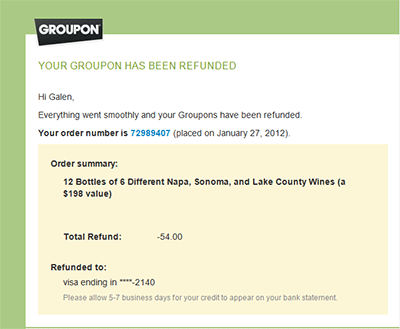When Groupon Promotes a Really Bad Deal
When I look at a Groupon deal I assume that the deal-making company has been vetted by Groupon. I expect that Groupon has made sure that the company is real and is sufficiently big to handle the traffic that the deal will bring them.
As a consumer I took comfort in believing that Groupon knew its deal makers were quality companies. After all, Groupon was standing in front of a company, and their reputation was at stake.
I have bought 10’s of Groupons and have had no problems. I felt that any Groupon I bought would lead me to a quality company whose products and service I could safely sample at a reduced cost.
I have learned better. Buyer beware!
Bin32 is a Napa wine seller who offered a Groupon for $198 of wine for only $54. Great!
Except that in February when I went online, selected my wines, and went to check-out, the Groupon did not cover the full amount of the charge. In addition to shipping, which was an acceptable extra, in my opinion, there $4.54 was not covered. I gave the site my credit card to get the order placed, and decided to complain to Groupon separately. Groupon emailed me back after a day or so that Bin 32 reported that they charged the extra amount for ” … for all taxes and processing fees.” Of course, $4.54 is not a tax amount or anything that maths out. It was just Bin 32 trying to get more money. After I complained again, Groupon gave me a $10 credit for my inconvenience. I was more than made whole, so I was happy.
Except the wine never arrived. After about a month I checked the Bin 32 site and saw that my order status was “Processing”. I sent Bin 32 email inquiries (I could not find a phone number on their web site) in March and then again in April. Nothing.
When I checked a couple days ago — we’re now in May — my order on the Bin 32 site was listed as “Complete” and there was a note that the order had shipped by UPS. Except, of course, I hadn’t received any wine.
I contacted Groupon yesterday, and today I received a full credit for what I paid Groupon. I am still out about $13 that was charged to my AMX, but after the earlier $10 Groupon credit, I am only really in the hole for $3 and change.
$3 is a pretty cheap cost for a consumer education. Here’s what I’ve learned:
- First the positive. Groupon has been responsive and wonderful.
- But, Groupon doesn’t do a flawless job of researching its dealers. Bin 32 has 78 ratings on Yelp. All of them are 1-star. Some of the Yelpers complain that in addition to not delivering the goods, BIN32 kept charging their debit and credit cards for orders not placed.
Yelp’s deals include links to the business’ ratings page on their site. That’s handy. In the future, I am going to be more careful when buying a Groupon and do some research before clicking “Buy”.


 One tries to trick you into logging into your Facebook account to see the new features available to you. This is a really clever angle since earlier this week Facebook unleashed a site redesign which has been widely panned in part because Facebook didn’t pre-announce the changes or explain them.
One tries to trick you into logging into your Facebook account to see the new features available to you. This is a really clever angle since earlier this week Facebook unleashed a site redesign which has been widely panned in part because Facebook didn’t pre-announce the changes or explain them. Here’s how I quickly spotted these messages as phony:
Here’s how I quickly spotted these messages as phony: